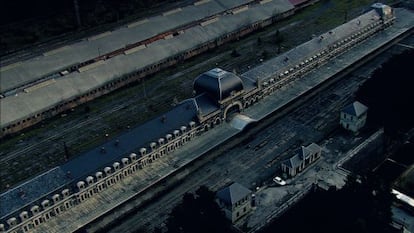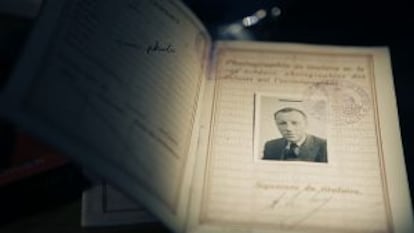‘Casablanca’ in the Pyrenees
A hub for spies and refugees during the Second World War, Canfranc station is the subject of two new documentaries


There were Allied spies. There were German informants, Gestapo officers, and snitches for Marshall Petain’s France and the local police. There were bars, full of cigarette smoke and furtive glances, where people met up in search of information or false passports to cross the border. As a key crossing point for goods in the middle of World War II, the town was a hub for smugglers, as well as home to one legendary charmer who used his savoir faire to pull the strings of an intricate espionage network.
Described like that, the town sounds like Casablanca of the classic Humphrey Bogart movie. But the fictional version of the Moroccan city had a real-life reflection in Canfranc, the international railway station on the border between Spain and France in the central Pyrenees in Huesca. During World War II it was a strategic crossing point for goods between Spain and Germany: food, tungsten, steel, not to mention 86 tons of German gold — 12 tons of which remained with the Franco government.
The legendary charmer was Albert Le Lay, the French customs chief, who surreptitiously snuck hundreds of Jews fleeing the Nazi regime across the border, among them the artists Max Ernst and Marc Chagall. The singer and dancer Josephine Baker, who was married to a French Jew, also crossed the border through Canfranc, though in more overt style, calling up the press so as to ensure no policeman would dare lay a finger on her or her husband in front of the reporters.
Those turbulent times full of anonymous heroes are now the subject of two new documentaries. The first, El rey de Canfranc (or, The king of Canfranc), directed by Manuel Priede and José Antonio Blanco, depicts the incredible life of Le Lay, a hero of the French Resistance who turned down an offer from Charles de Gaulle to run a ministry.
Le Lay snuck hundreds of Jews fleeing the Nazis across the border
In the second, Juego de espías (Spy games), directed by Germán Roda and Ramón J. Campo — the journalist who has researched the story of Canfranc the most — La Ley is a supporting character, just one more piece in a network of spies set up by British Intelligence that used the border crossing as a center for compiling and exchanging information. Every week the Basque, Aragonese and French recruits’ information was sent from Canfranc via Zaragoza to San Sebastián where the British consulate forwarded it by diplomatic bag to Madrid.
José Antonio Blanco takes a school exercise book out of his backpack. Inside, scrupulously recorded in Le Lay’s own handwriting, are the donations the refugees made to him. “We were pulling the thread and arrived at Le Lay’s grandson and he opened up the door to his family,” Blanco explains. “Le Lay is fascinating because of the multiple networks he wove, his ability to get in touch with any kind of person. He arrived in 1940, when there weren’t yet any Nazis in that central corridor. They would soon reach there, and he outwitted the Gestapo time and time again. [He] ended up getting away by the skin of his teeth. He continued in the resistance as leader and when the war finished — after receiving all sorts of honors — he retired to Saint-Jean-de-Luz. He asked his family to stay as silent as tombs about his exploits.”

Juego de espías follows the journey of the documents from Canfranc to San Sebastián in the hands of young courier Lola Pardo, the girlfriend of a Civil Guard who crops up in both films. The spy network was made up not just of leftists, but also monarchists, Falangists, Spaniards, and Frenchmen. They lived in constant danger, helping the Allies work out the number of fascist troops in southern Europe. Director Germán Roda says: “It’s a story that goes beyond people; rather it is one of ideas, in which the Spaniards are the idealists, because that war made no difference to them.”
Tu suscripción se está usando en otro dispositivo
¿Quieres añadir otro usuario a tu suscripción?
Si continúas leyendo en este dispositivo, no se podrá leer en el otro.
FlechaTu suscripción se está usando en otro dispositivo y solo puedes acceder a EL PAÍS desde un dispositivo a la vez.
Si quieres compartir tu cuenta, cambia tu suscripción a la modalidad Premium, así podrás añadir otro usuario. Cada uno accederá con su propia cuenta de email, lo que os permitirá personalizar vuestra experiencia en EL PAÍS.
¿Tienes una suscripción de empresa? Accede aquí para contratar más cuentas.
En el caso de no saber quién está usando tu cuenta, te recomendamos cambiar tu contraseña aquí.
Si decides continuar compartiendo tu cuenta, este mensaje se mostrará en tu dispositivo y en el de la otra persona que está usando tu cuenta de forma indefinida, afectando a tu experiencia de lectura. Puedes consultar aquí los términos y condiciones de la suscripción digital.
Últimas noticias
Most viewed
- Why we lost the habit of sleeping in two segments and how that changed our sense of time
- Trump’s obsession with putting his name on everything is unprecedented in the United States
- Pablo Escobar’s hippos: A serious environmental problem, 40 years on
- The Florida Keys tourist paradise is besieged by immigration agents: ‘We’ve never seen anything like this’
- Charles Dubouloz, mountaineering star, retires at 36 with a farewell tour inspired by Walter Bonatti








































